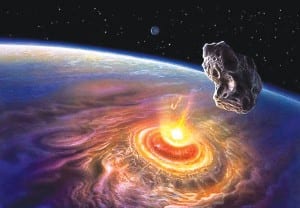The Zimbabwe Star news outlet has covered the research of SMU archaeologist David J. Meltzer with the article “Comet not behind mass extinction at Ice Age end: Study.”
A member of the National Academy of Sciences, Meltzer researches the origins, antiquity, and adaptations of the first Americans who colonized the North American continent at the end of the Ice Age. He focuses on how these hunter-gatherers met the challenges of moving across and adapting to the vast, ecologically diverse landscape of Late Glacial North America during a time of significant climate change.
The Zimbabwe Star, from the IANS news service, highlights Meltzer’s latest study to show that a comet, or any other kind of extraterrestrial impact, was not responsible for sudden climate change at the end of the Ice Age 12,800 years ago. Proponents of the comet-impact theory have pointed to sedimentary deposits that they say prove that an object from outer space hit the Earth, extinguishing the Clovis culture and causing the mass extinction of many animals.
EXCERPT:
Zimbabwe Star (IANS)
Archaeologists have debunked the cosmic-impact theory that a comet sparked climate change at the end of the Ice Age, causing mass animal extinction.According to the study, led by archaeologist David Meltzer from Southern Methodist University in Dallas, Texas, nearly all sediment layers purported to be from the Ice Age at 29 sites in North America and on three other continents are actually either much younger or much older.
Meltzer and his co-authors found that only three of 29 sites commonly referenced to support the cosmic-impact theory actually date to the window of time for the Ice Age.
“The supposed impact markers are undated or significantly older or younger than 12,800 years ago. Either there were many more impacts than supposed, including one as recently as five centuries ago, or, far more likely, these are not extraterrestrial impact markers,” Meltzer noted.
Scientists agree that the brief episode at the end of the Ice Age – officially known as the Younger Dryas for a flower that flourished at that time – sparked widespread cooling of the earth 12,800 years ago and that this cool period lasted for 1,000 years.
But theories about the cause of this abrupt climate change are numerous.
They range from changes in ocean circulation patterns caused by glacial meltwater entering the ocean to the cosmic-impact theory.
Meltzer and his colleagues sorted the 29 sites by the availability of radiometric or numeric ages and then the type of age control, if available, and whether the age control is secure.
Follow SMUResearch.com on Twitter.
For more information, www.smuresearch.com.
SMU is a nationally ranked private university in Dallas founded 100 years ago. Today, SMU enrolls nearly 11,000 students who benefit from the academic opportunities and international reach of seven degree-granting schools. For more information see www.smu.edu.
SMU has an uplink facility located on campus for live TV, radio, or online interviews. To speak with an SMU expert or book an SMU guest in the studio, call SMU News & Communications at 214-768-7650.



 Real-time audio of corporal punishment shows kids misbehave within 10 minutes of spanking
Real-time audio of corporal punishment shows kids misbehave within 10 minutes of spanking Conventional vs. modern: Repertoire drives opera house identity, market share
Conventional vs. modern: Repertoire drives opera house identity, market share Women have made strides for equality in society, but gender gap still exists in art museum directorships
Women have made strides for equality in society, but gender gap still exists in art museum directorships Search for dark matter covers new ground with CDMS experiment in Minnesota
Search for dark matter covers new ground with CDMS experiment in Minnesota